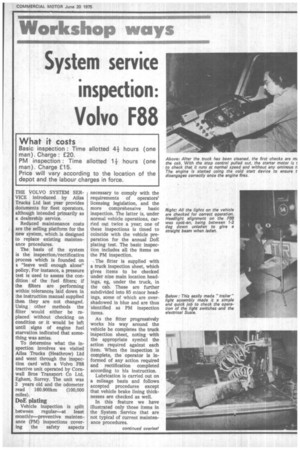System service inspection: Volvo F88
Page 83

If you've noticed an error in this article please click here to report it so we can fix it.
THE VOLVO SYSTEM SERVICE introduced by Ailsa Trucks Ltd last year provides documents for fleet operators, although intended primarily as a dealership service.
Reduced maintenance costs are the selling platform for the new system, which is designed to replace existing maintenance procedures.
The basis of the system is the inspection/rectification process which is founded on a "leave well enough alone" policy. For instance, a pressure test is used to assess the condition of the fuel filters; if the filters are performing within tolerances laid down in the instruction manual supplied then they are not changed. Using other methods the filter would either be replaced without checking on condition or it would be left until signs of engine fuel starvation indicated that something was amiss.
To determine what the inspection involves we visited Ailsa Trucks (Heathrow) Ltd and went through the inspection card with a Volvo F88 tractive unit operated by Cornwall Bros Transport Co Ltd, Egham, Surrey. The unit was 2 years old and the odometer read 160.900km (100,000 miles).
DoE plating Vehicle inspection is split between regular—at least monthly—preventive maintenance (PM) inspections covering the safety aspects necessary to comply with the requirements of operators' licensing legislation, and the more comprehensive basic inspection. The latter is, under normal vehicle operations, carried out twice a year; one of these inspections is timed to coincide with the vehicle preparation for the annual DoE plating test. The basic inspection includes all the items on the PM inspection.
The fitter is supplied with a truck inspection sheet, which gives items to be checked under nine main location headings, eg, under the truck, in the cab. These are further subdivided into 85 minor headings, some of which are overshadowed in blue and are thus identified as PM inspection items.
As the fitter progressively works his way around the vehicle he completes the truck inspection sheet, noting with the appropriate symbol the action required against each item. When the inspection is cotnplete, the operator is informed of any action required and rectification completed according to his instruction.
Lubrication is carried out on a mileage basis and follows accepted procedures except that vehicle brake lining thicknesses are checked as well.
In this feature we have illustrated only those items in the System Service that are not typical of current maintenance procedures.




























































































































































